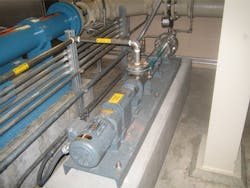A Quick Custom Pump Solution
Located in Clark County, Nev., the city of North Las Vegas is the fourth largest city in the state. Serving a population of 224,000 residents, the city operates a water reclamation facility that handles a current average flow of 17 million gal (64.5 million liters) per day. This facility provides the city with the ability to maximize the operational efficiency of wastewater treatment and water resources as well as produce extremely clear reclaimable water.
Recently the city’s water reclamation facility installed three centrifuges to dry sludge along with three progressing cavity pumps (from a Netzsch competitor) to pump the dewatered sludge from the treatment plant approximately 100 ft (30.5 meters) to a loading dock where it is loaded into trucks for transport. The progressing cavity pumps were designed to operate at 200 psi (14 bar), but during plant operation, the actual system pressure was 290 psi (20 bar). With the head too high for the pumps to handle, maintenance problems began to mount including pressure switch failures and accelerated wear on major pump components.
Customer Seeks a Solution
Bruce Loring, a vice president with James Cooke & Hobson Inc. in Phoenix, took the call from the customer, Kenny Eickelberg, plant engineer and Layton Brown, chief of maintenance, both with the city of North Las Vegas. Loring noted that with the ongoing operational and maintenance issues in this dewatering application, “the customer needed to get a lube pump system designed, built and installed quickly.” Loring recalled that, “the manufacturer of the original pump system quoted a 15-week delivery schedule for a lube pump system. Netzsch already had a presence at this facility with polymer pumps and thickened sludge pumps operating in the water reclamation plant and when I reached out to Netzsch, they said they could design, build and install a custom lube pump solution in six weeks.”
The technical solution from Netzsch was to use a Friction Loss Reduction System (FLRS). The FLRS consists of a multi-stage Netzsch progressing cavity pump and a Netzsch ring nozzle. The system works by pumping a lubricant through the pump to the ring nozzle. The 8-in. (200 mm) Netzsch ring nozzle was designed to provide a continuous 360-degree even layer of water around the entire inside pipe surface so that the dried sludge would move through the pipe at a lower pressure. In this case, the customer decided to use water as the lubricant instead of polymer to reduce costs. While the original design of the dewatered sludge pumping system did not include a lube system, the Netzsch FLR system was able to be installed in the first possible flange connection after the competitor’s pump. Netzsch is also able to supply products for pumping sludge cake of up to 50% of solids content, equipped with bridge-breaking devices such as paddles and the patented aBP-Module.
System Pressure Lowered
Loring noted that, “by continuously injecting water in the annulus of the pipe, it lowered the pressure tremendously.” The resulting customer benefit was that the pressure in the system was reduced from almost 300 psi (20 bar) to 150 psi (10 bar) leading to safer system operation. Once the first Netzsch Friction Loss Reduction System was installed, it was quickly followed by two more so that all three of the sludge drying lines at the water reclamation plant now incorporate a Netzsch FLRS. With the Netzsch FLRS operating for approximately two years, the customer has seen a longer service life for of parts (rotor/stator) for the dewatered sludge pump. An additional benefit for the customer was a lower energy demand for pumping the dewatered sludge.
The bottom line, Loring said, is that, “without the lube pump solution from Netzsch, the other pump systems would not have survived.”
Jeff Helm is West regional sales manager for Netzsch Pumps North America LLC. Helm can be reached at [email protected] or 484.886.8078.
